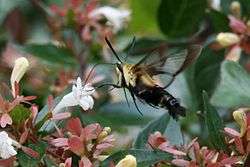Abelia
| Abelia | |
|---|---|
 | |
| Abelia mosanensis | |
| Scientific classification | |
| Kingdom: | Plantae |
| (unranked): | Angiosperms |
| (unranked): | Eudicots |
| (unranked): | Asterids |
| Order: | Dipsacales |
| Family: | Caprifoliaceae (Linnaeaceae) |
| Genus: | Abelia'" R.Br. |
| Species | |
|
See text | |
Abelia /əˈbiːliə/[1] is a genus of about 30 species and many hybrids in the honeysuckle family Caprifoliaceae. Some authors, including the Angiosperm Phylogeny Group, consider Abelia and related genera to belong instead in the segregate family Linnaeaceae, also including such genera as Linnaea, Abelia, Dipelta, Kolkwitzia, and Zabelia, but not such others as Lonicera or Symphoricarpos, included by them instead in a more narrowly viewed Caprifoliaceae.
Abelias are shrubs from 1–6 m tall, native to eastern Asia (Japan west to the Himalaya) and southern North America (Mexico); the species from warm climates are evergreen, and colder climate species deciduous. The leaves are opposite or in whorls of three, ovate, glossy, dark green, 1.5–8 cm long, turning purplish-bronze to red in autumn in the deciduous species. The flowers appear in the upper leaf axils and stem ends, 1-8 together in a short cyme; they are pendulous, white to pink, bell-shaped with a five-lobed corolla, 1–5 cm long, and usually scented. Flowering continues over a long and continuous period from late spring to fall.
Type species of this genus is Abelia chinensis. The generic name commemorates Clarke Abel, a keen naturalist who accompanied Lord Amherst's unsuccessful embassy to China in 1816 as surgeon, under the sponsorship of Sir Joseph Banks. All of Abel's seeds and plants were lost in a shipwreck on the homeward voyage, however; living plants of Abelia chinensis were first imported to England in 1844 by Robert Fortune, who introduced A. uniflora the following year.[2]
The showy semi-hardy Mexican A. floribunda of the Cordillera of Oaxaca was introduced to English horticulture in 1841.[3]
- Selected species
|
|
- Hybrids
- Abelia x grandiflora Hort. ex. Bailey
Ecology

Abelia species are used as food plants by the larvae of some Lepidoptera species (see list of Lepidoptera that feed on Abelia), and also serve as a nectar source for some insects.
Cultivation and uses
Abelias are popular garden shrubs. The most widely grown is the hybrid Abelia x grandiflora (Glossy Abelia; hybrid Abelia chinensis x Abelia uniflora). This is a rounded, spreading, multi-stemmed shrub with gracefully arching branches to 1-1.8 m tall, with ovate, glossy, dark green semi-evergreen leaves to 2–6 cm long, and clusters of white-tinged-pink, bell-shaped flowers to 2 cm long.
References and external links
| Wikimedia Commons has media related to Abelia. |
- Barnes, P. 2001. Looking at Abelias. New Plantsman 8(2): 78-92 (clarification of nomenclature, history, and cultivars with an excellent key and photographs).
- Flora of China: Abeila species list
- Germplasm Resources Information Network: Abeila
- Mexican Abelia
- Abelia page
- Two new species of Abelia